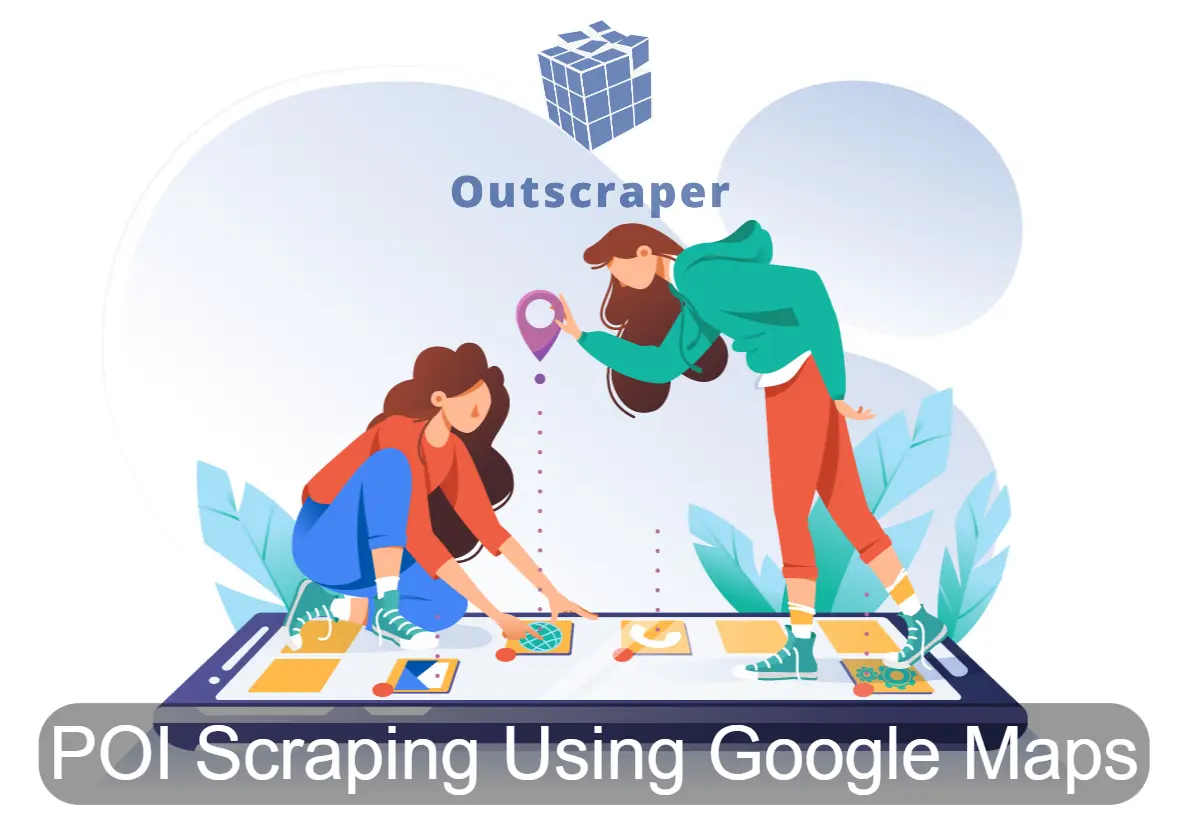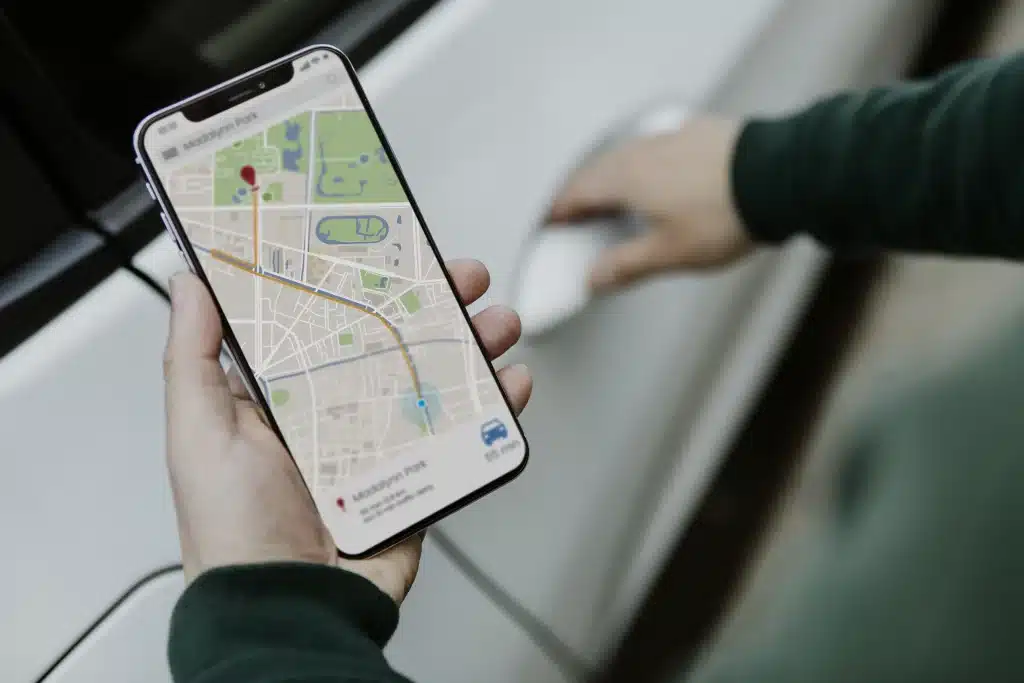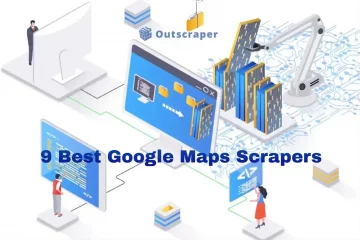Points of Interest (POI) Scraping Using Google Maps
Оглавление
Introduction to POI
Points of Interest (POIs) in Google Maps refer to locations that might interest users, such as landmarks, businesses, tourist attractions, and more. These include restaurants, hotels, museums, parks, and other notable spots. POI is also a term used in cartography to describe the choice to represent a particular feature using an icon that occupies a particular point. We will share how to master Google Maps and provide strategies for effective POI scraping using Outscraper’s Google Maps Data Scraper service.
Google Maps uses these points to help users find places and plan routes effectively, providing information such as the name, location, and details about the services offered at these points. Five factors distinguish high-quality POI data: freshness, coverage, consistency, ease of use, and customization. Using scraped POI data from Google Maps is one strategy businesses use to improve their lead-generation activities and acquire more customers.
Prominent example of the Types of POI
- Tourist attractions
- Churches, schools, town halls, distinctive buildings
- Post offices, shops, post boxes, telephone boxes
- Pubs (pub names are helpful when navigating by map)
- Car parks and lay-bys (and whether free or not)
- Museums, hospitals, shopping malls, hotels, and gas stations
Relevance of POIs to Businesses and Individuals
POIs have many use cases, such as easy access to the vast database of business locations. In the tourism industry, they can serve as visitor reference points and provide detailed information about attractions. They can also be used to plan routes and provide efficient route navigation in the transportation industry. In Biology and environmental sciences, POIs can define species’ habitats, track their movements, and study their ecological interactions.
Points of Interest (POIs) can serve various purposes specific to different industries and provide people with a wide range of information related to the area. Users of mobile devices can benefit from geolocation and time-based POI services that recommend nearby geolocations. Mobile users will mostly rely on POIs to navigate their environment and find transportation, stores, restaurants, hotels, and parking areas, to name a few. POIs are also considered crucial data in terms of location intelligence platforms.
Google Maps: Valuable Source of POI Data
The most popular app for navigation, with more than a billion monthly users worldwide, Google Maps sets a high standard in digital mapping solutions due to its extensive POI data. It leverages a database of POI data to offer its users hyper-local information that is both relevant and valuable.
Google Maps is a valuable source of POI data because it has the most extensive and complete list of POIs worldwide. Outscraper was able to integrate Google Maps as a valuable source of POI data. It offers the largest and most comprehensive collection of POIs worldwide and serves as an attractive platform for B2B to get clients. Business owners and millions of users regularly and continuously update data from Google Maps.
Google Maps is a valuable source of data that provides an extensive range of information such as popular times, working hours, business status, and more than 40 additional fields. It has comprehensive coverage and a worldwide presence in every country and every city, providing comprehensive coverage for users in various locations.
Understanding POI Scraping
To understand POI scraping, we should first define web scraping in general. Web scraping is the automated process of extracting data from websites using software tools called web scrapers, also known as web crawlers. These tools simulate human browsing behavior to navigate web pages, retrieve desired information, and store it for analysis or other purposes.
Points of Interest (POI) scraping refers to extracting Point of Interest data from online maps such as Google Maps or directories. It automatically gathers information about these locations, including their names, addresses, contact details, ratings, and other relevant data. This scraped data can be used for various purposes, such as creating business directories, analyzing market trends, or enhancing location-based services.
Techniques for Effective POI Scraping
When scraping data from Google Maps, you’ll typically interact with the web interface or utilize the Google Maps API. To do so, you must understand the basics, such as manual scraping or searching for the desired location. Copy and paste relevant information, such as names, addresses, and contact details, into a spreadsheet or text file.
It would help if you also learned other techniques in web scrapings, such as HTML parsing, API Integration, Proxy Rotation, and Rate Limiting because Google Maps API prevents exceeding usage quotas. You also need to learn Data Storage and Processing to store scraped data in a database for further analysis and clean and preprocess the data to ensure accuracy.
Advanced POI Scraping Methods and Strategies
To use advanced POI database scraping methods and strategies, you must employ sophisticated techniques to overcome challenges and extract comprehensive data from mapping platforms like Google Maps. Here are some of the advanced techniques:
- API Integration: You can utilize the official APIs provided by mapping platforms, such as Google Maps Places API, and access structured POI data directly through API requests.
- Apply Machine Learning and Natural Language Processing: Extract structured data from unstructured text in POI descriptions, reviews, or user comments by applying Machine Learning and Natural Language Processing.
- Design a Scalable Infrastructure: To handle large-scale POI scraping tasks efficiently, you should design a scalable infrastructure using cloud computing platforms like Amazon Web Services (AWS) or Google Cloud Platform (GCP).
- Geospatial Analysis: Perform geospatial analysis to enrich POI data with additional geographic attributes and insights. You can visualize POI data on interactive maps and analyze spatial patterns, clusters, or hotspots using tools like Mapbox or Leaflet.
- Temporal Analysis: Incorporate techniques to capture temporal dynamics and changes in POI data over time.
- Data Enrichment: Integrate POI data from multiple sources and providers to create comprehensive and enriched datasets.
- Ethical Considerations and Compliance: Adhere to legal and ethical guidelines when scraping POI data, including compliance with website terms of service, copyright laws, and privacy regulations. Try to anonymize or aggregate sensitive information as much as possible and obtain proper authorization and consent when scraping user-generated content.
The advanced methods and strategies can enhance data quality, scalability, and analytical capabilities for more robust and insightful analyses of geographic information and location-based services when incorporated into your POI scraping workflow.
Challenges in POI Scraping and How Outscraper Solved These Problems
POI scraping had challenges and limitations like any other form of web scraping. Still, the Outscraper team used advanced technologies to solve these challenges and provide you with more comprehensive and verified scraping data.
Let’s examine some of the most common challenges and limitations in POI scraping.
- Anti-Scraping Measures: Websites may implement measures to deter scraping, such as CAPTCHAs, rate limiting, or IP blocking. The engineers of Outscraper solved all these measures, so you will no longer have to worry about CAPTCHAs, rare limiting, or IP blocking.
- Website Structure Changes: Websites, including mapping platforms like Google Maps, frequently update layouts and structures. Outscraper’s engineers worked round-the-clock to monitor website structure changes and update their technology with the said changes.
- Dynamic Content: Mapping platforms often use dynamic content loading techniques, such as AJAX or JavaScript, to update page content dynamically. Outscraper’s advanced tools go beyond traditional scraping methods, so dynamic content is no longer a problem.
- API Limitations and Costs: Google Maps’ APIs can simplify data access, but they come with usage limits, quotas, and associated costs. Outscraper’s advanced technologies solved this kind of challenge.
- Data Volume and Scale: Scraping large volumes of POI data from extensive geographic areas can be resource-intensive and time-consuming.
- Data Quality and Consistency: Another challenge is data quality and consistency, as scraped data may contain errors, inconsistencies, or inaccuracies, especially when dealing with user-generated content or unstructured data.
- Data Maintenance and Updates: POI data is dynamic and subject to frequent changes. However, with the technologies employed by Outscraper’s engineering team, all the scraped data are maintained and regularly updated.
- Geographical Coverage: Mapping platforms may limit the availability or accuracy of POI data in specific regions or countries.
- Legal and Ethical Concerns: Web scraping activities must comply with legal requirements and ethical guidelines. Scraping and extracting public data is protected by the First Amendment of the United States Constitution.
Outscraper addressed these challenges and limitations using advanced technologies, a combination of technical expertise, careful planning, and adherence to legal and ethical guidelines. By understanding and mitigating these challenges, Outscraper users can conduct POI scraping activities effectively while respecting data providers’ and users’ rights and interests.
Conclusion
POIs are very important, as we highlighted their role in helping users find places efficiently and plan routes effectively. We have discussed the key factors that define high-quality POI data, emphasizing freshness, coverage, consistency, ease of use, and customization.
Detailing examples of POIs, such as tourist attractions, schools, shops, and gas stations, underscores the diverse locations within POI data and their relevance across various industries, including tourism, transportation, and environmental sciences.
Furthermore, we also discussed the value of Google Maps as a primary source of POI data. We explore techniques for effective POI scraping, ranging from manual methods to advanced approaches like API integration and machine learning. Despite challenges such as anti-scraping measures, dynamic content, and legal concerns, we highlighted how Outscraper addresses these obstacles through advanced technologies and adherence to ethical guidelines.
Overall, this article serves as a guide for mastering Google Maps and effective POI scraping strategies. It provides insights into the importance of POIs, data extraction techniques, and solutions to overcome challenges in acquiring and utilizing POI data for various purposes by employing the advanced technologies from Outscraper. If you want to learn more about Points of Interest and how to enrich POI Data with Google Maps, you can also read the previous article on Outscraper.
However, if you are in a hurry and don’t have time to wait for the scraping results, you can also try our partner service, Targetron. This ready-made directory of POI data uses the same technology employed by Outscraper. Ensure you understand the difference between Targetron and Outscraper when providing POI data.
Попробуйте бесплатно прямо сейчас
Register now to try the Outscraper Парсер Google Maps freely. If your project has special needs, please contact us. Our developer team will recommend the best solution for you. You can reach us on the Связаться с Нами page or create a meeting on Calendly to answer your questions.
Pay as you go without monthly subscription fees. 50 free searches per month. Sign up and try it for free now.
Часто Задаваемые Вопросы
Наиболее частые вопросы и ответы
Сбор, сбор или извлечение карт Google Map - это процесс получения всей информации о местах (название, адрес, координаты, сайт, телефон, часы работы и т. Д.) С сайта Google Maps. Он автоматизирует ручной экспорт данных.
Сбор и извлечение общедоступных данных защищены Первой поправкой к Конституции США.
No. All scraping activities occur on Outscraper servers, ensuring that your IP address is not utilized for data scraping. You can close your computer an the scraping task will still be running.
POI data refers to “Points of Interest” data. In the context of mapping, navigation, and location-based services, a Point of Interest (POI) is a specific location that someone may find useful or interesting. Examples of POIs include:
- Restaurants
- Gas stations
- Museums
- Tourist attractions
- Hospitals
Schools - Shopping malls
- Hotels
POI data typically contains information about these locations, such as their names, addresses, types or categories, phone numbers, website URLs, and geographical coordinates (latitude and longitude). This data is valuable for various applications, including GPS navigation systems, travel websites, local search services, and many other location-based services or applications.
A POI (Point of Interest) database is a collection of data points that represent specific locations or destinations that might be of interest to users, especially in the context of navigation and location-based services.
Each POI typically contains information like:
- Name of the location
- Address
- Geographic coordinates (latitude and longitude)
- Type or category (e.g., “restaurant” or “museum”)
- Additional details such as phone numbers, operating hours, ratings, or reviews
POI databases are commonly used in GPS devices, mapping software, and mobile apps to help users find and navigate to specific locations. They can be sourced from various providers, and some databases are more comprehensive or specialized than others. For instance, a hiking app might have a POI database focused on trails, campsites, and natural landmarks, while a city travel guide app might prioritize restaurants, museums, and historical sites.




